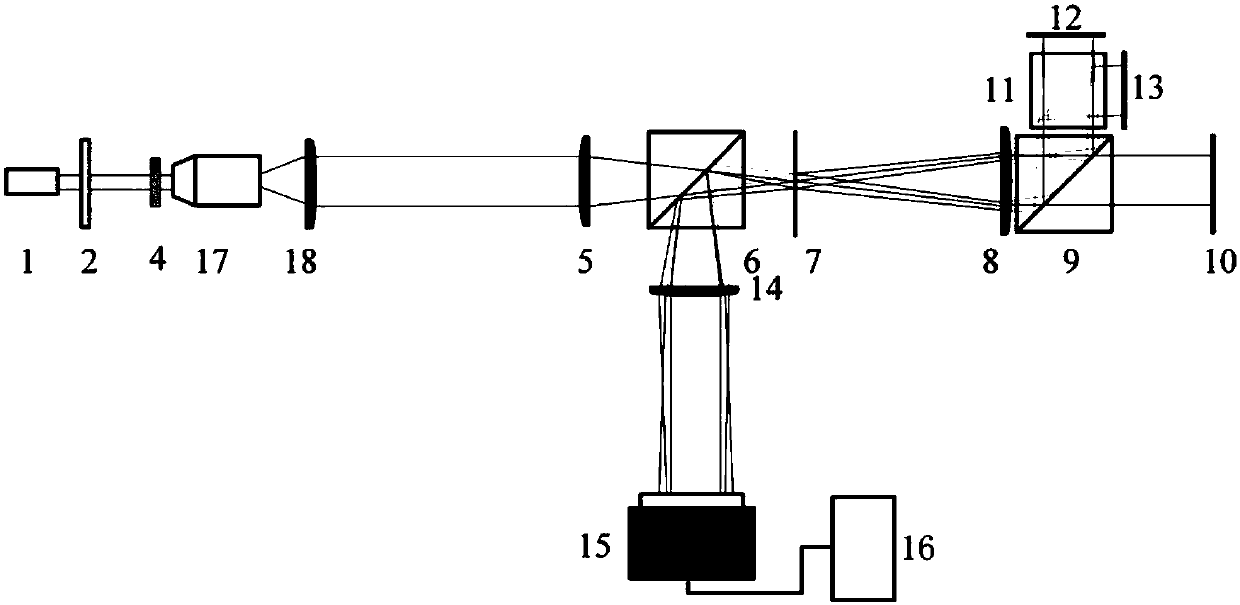Polarization parameter measuring device based on carrier frequency orthogonal transmission point diffraction digital holography and measuring method thereof
A technology of digital holography and measuring devices, applied in measuring devices, optical radiation measurement, and measuring the polarization of light, can solve problems affecting the measurement accuracy of polarization state parameters, limited spectrum space separation, and increased system complexity, etc., to achieve system positioning Low complexity requirements, avoiding crosstalk between spectrums, and compact structure
- Summary
- Abstract
- Description
- Claims
- Application Information
AI Technical Summary
Problems solved by technology
Method used
Image
Examples
Embodiment approach 1
[0035] Implementation mode one: if figure 1 As shown, a polarization state parameter measurement device based on carrier-frequency orthogonal transmission point diffraction digital holography includes a light source with a wavelength of λ, a 45° linear polarization modulation system, and a collimated beam expander system. The device also includes a first lens, A first non-polarizing beam splitter, an aperture array, a second lens, a second non-polarizing beam splitting prism, a first plane mirror, a polarizing beam splitter, a second plane mirror, a third plane mirror, a third lens, an image sensor and Computer; the light beam emitted by the light source is modulated by a 45° linear polarization modulation system to form a linearly polarized light beam. After being collimated and expanded by the collimation beam expansion system, it passes through the object to be measured, the first lens, and the first non-polarizing beam splitter in turn. , the hole array, the second lens, a...
Embodiment approach 2
[0036] Embodiment 2: On the basis of Embodiment 1, the first plane reflector is placed vertically to the optical axis, and the second plane reflector is at an angle θ to the optical axis in the horizontal direction. a angle placement, θ a The angle does not include 90°, the third plane reflector is at the angle θ with the optical axis in the vertical direction b angle placement, θ b Angles do not include 90°.
Embodiment approach 3
[0037] Embodiment 3: On the basis of Embodiment 1 or 2, the pinhole B on the hole array a Matches the light spot reflected by the third plane mirror and focused by the second lens, pinhole B b The light spot is matched with the light spot reflected by the second plane reflector and focused by the second lens.
[0038] Based on Embodiment 1, 2 or 3, a measurement method of a polarization state parameter measurement device based on carrier frequency orthogonal transmission point diffraction digital holography, the implementation process is as follows:
[0039] (1) Adjust the entire optical system, turn on the light source, and the emitted beam with a wavelength of λ is modulated by a 45° linear polarization modulation system to form a linearly polarized beam. After being collimated and expanded by the collimator beam expander system, it passes through the object to be measured and the first lens to form a focused beam, and then pass through the first non-polarizing beam splitte...
PUM
 Login to View More
Login to View More Abstract
Description
Claims
Application Information
 Login to View More
Login to View More - R&D
- Intellectual Property
- Life Sciences
- Materials
- Tech Scout
- Unparalleled Data Quality
- Higher Quality Content
- 60% Fewer Hallucinations
Browse by: Latest US Patents, China's latest patents, Technical Efficacy Thesaurus, Application Domain, Technology Topic, Popular Technical Reports.
© 2025 PatSnap. All rights reserved.Legal|Privacy policy|Modern Slavery Act Transparency Statement|Sitemap|About US| Contact US: help@patsnap.com



